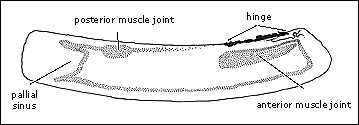|
Plankton eater
When the clam has buried
itself in the sand, only the upper parts of its siphon are
visible. With large individuals the siphons can be as large
as 0,5 cm in diameter. Through its inhalent siphon water is
pumped, and with it small microscpic organisms follow that
are filtered out and eaten, afterwards the water is pumped
out through the exhalent siphon.
Is fished
Razor clams are fished commercially as
bait and food. In Europe, tens of thousands of tons are harvested annually.
They are also fished commercially in the U.S. Razor clams are boiled for
5 minutes and can be eaten immediately or used as an ingredient in soups
with root vegetables.
There are two ways to fish Razor clams. One way is to use
a sort of pike, about 60-70 cm long, flattened at the end and furnished
with two barbs. The pike is stuck in the sand beside the clam and is then
drawn up with the barbs. The other way is to pour a handfull of salt on
the siphons which inhale the salt, whereby the clam becames irritated
and creeps out of its hole.
Other Razor clams
In Swedish waters there are five specie
of Razor clam belonging to the Ensis family. To distinguish between
the species is difficult and they need to be examined internally. First
the front and back adductor scars (where the muscle is attached to the
shell), mantle and the shell hinge. Look at the next page!

|

|
Page
3 of 4
|

|
|